Foreign Insulators
by Marilyn Albers
Reprinted from "Crown Jewels of the Wire", February 2001, page 9
THE YEAR 2001 BRINGS IN MORE
CD'S, EMBOSSINGS, AND COLORS
The insulator you see here was found in the city of Vardon, Hungary by a
fellow insulator collector named Zoltan Drinoczy, who discovered a small but
very old power line in the process of being rebuilt. He remembers seeing some
discarded glass insulators that came off the neutral line of high voltage
circuits. Some of the glass colors were grayish clear and others had a brown
tint. He asked the workmen if he could have them and apparently the answer was
"Yes". These particular insulators are unusually thick and heavy for
their small size. In fact, just one tips the scale at 1 lb., 3 oz. Apparently
they are all unembossed, so we don't know anything about the manufacturer that
produced them, but they are a new style from a foreign country, and that's
always exciting!
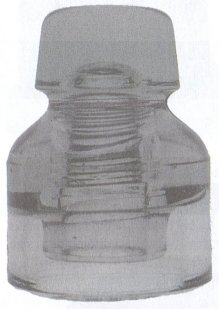
"New CD 455"
Zoltan had more information for us and here is what he had to
say: "The voltage of the old line was 190/110. At the time the line was
erected, the Hungarian norm required the high voltage wires to be supported by
white porcelain insulators and the neutral lines to be supported by glass
insulators such as this type. Regulations in Hungary have since changed and high
voltage power lines now use glass suspension insulators. Presently, the
Hungarian norm requires that there be white porcelain insulators on the low
voltage lines and brown porcelain insulators on the neutral lines." Zoltan,
if you are reading this, we want to thank you for all the good information.
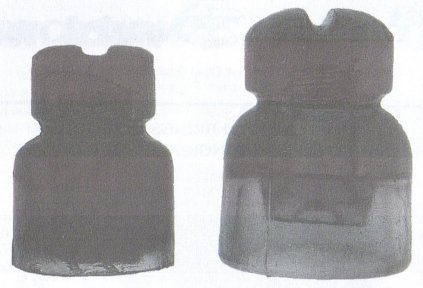
"New CD 570.6"
The insulator to the right in the photo is new CD 570.6. It appears to be the
big brother of CD 570.5 that you see on the left, which was first shown in the
August 2000 issue of Crown Jewels of the Wire magazine. Both insulators are made
of dark Hemingray blue glass but neither one is embossed. Their profiles are
similar but there is quite a difference in size. CD 570.5 is 3-1/2" in
height and CD 570.6 is 1/2" taller at 4-1/8". Both insulators were
found and used in Ukraine.
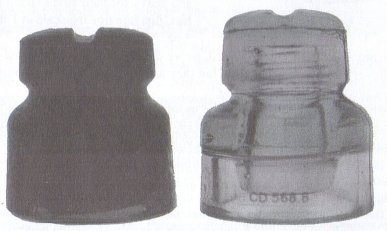
"Brothers under the skin"
The "brothers under the skin" insulators pictured on the previous
page have both been classified as new CD 568.8's because they are so close in
size and profile. They were used on telephone lines in either Russia or Ukraine
- or perhaps in both countries. The insulator on the left in the photo is the
most recent discovery of the two, and I'm told that this particular example did
actually come from Russia. The color of glass is a deep teal green and it is
just beautiful when held to the light, but when it just sits on the shelf it
looks like black glass. The insulator to the right in light blue aqua was the
first one to be dubbed as a CD 568.8. Neither of these two insulators is
embossed.
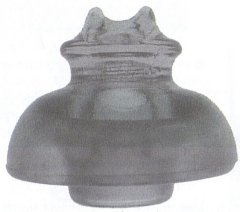
"CD 247.5 acquires a new embossing"
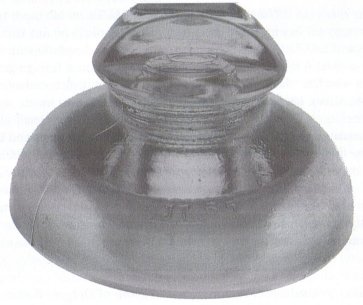
Here we have a new embossing for CD 247.5 and the glass color is a beautiful
shade of light citron green. The insulator was found in Ukraine. There is an
embossed triangle on the underside of the skirt, and inside it are the letters
"JT". Right next to that triangle is the number "65" indicating that the date of manufacture was probably 1965. There are no
other
markings on the insulator. To date I know of only one other glass insulator that
has this "JT" embossing on the underside of the skirt and it is a CD 304.5.
The embossing on that one is "WC-10B" with "JT" inside a
triangle similar to what we see when we look at the CD 247.5. I want to say that
the letters "J T" are probably the initials of a Russian manufacturer, but
I can't confirm it at this time.
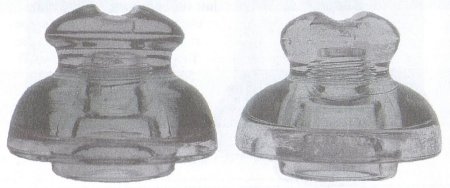
"New embossing for CD 611"
Our familiar CD 611 in light blue is on the left in the photo with the
embossing "MIVA // T1-CA". Just about every collector of foreign glass
insulators who has "the book" is aware of this one but just recently,
Guido Boreani of Milan, Italy and his German friend Ulrich Reiser from
Neckartenzlingen, Germany found a CD 611 variant in "near clear" glass
with the embossing "FIDENZA" // 6123". Seen with naked eyes and
lined up side by side, the profiles of these two insulators are not exactly
alike, but they share the same CD number because that's just about as close as
they can get without having to create a new CD number for every insulator that's
just a whisker away from being identical to a similar one, but still not exactly
the same. Remember too, that they have been made by different manufacturers but
they still do the same job.
Many thanks to insulator collectors Ernie Carlson of Oregan, Zoltan Drinoczy
from Hungary, Quenton Marty and Joel Anderson of Minneapolis, Guido Boreani from
Italy, Ulrich Reiser of Germany, and Tom Katonak from New Mexico, all of whom
have contributed information for this article.
| 